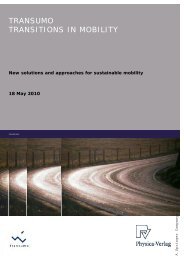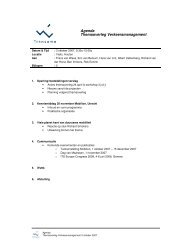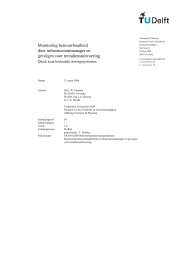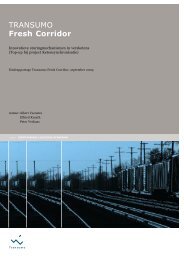Casestudie Breakdown prediction Contell PILOT - Transumo
Casestudie Breakdown prediction Contell PILOT - Transumo
Casestudie Breakdown prediction Contell PILOT - Transumo
You also want an ePaper? Increase the reach of your titles
YUMPU automatically turns print PDFs into web optimized ePapers that Google loves.
clustering as well as an analysis of historical data is often done by the use of artificial<br />
neural networks ([Blasig95], p. 3-4).<br />
The succeeding subsections will introduce artificial neural networks and will review<br />
their applicability to sensor based temperature monitoring data. A positive review<br />
would allow the usage of automated clustering and classification.<br />
5.9.2 Artificial Neural Networks<br />
Artificial neural networks are based on the functioning of a human brain. Every brain<br />
consists of neurons. These neurons are stimulated from neighbored neurons by<br />
chemical impulses, the so called neurotransmitters. Neurons transform incoming<br />
chemical impulses to electrochemical signals and relay them to the neighbored<br />
neurons. A regular exchange of these signals between two neurons leads to a high<br />
activation of this connection. By contrast, sparse communication leads to a low<br />
activation or even a loss of connection. ([Martin98], p. 262-263)<br />
The underlying basic principal is learning from failures. A connection that represents<br />
an error is assigned to a low activation level after recognition. By contrast, generally<br />
valid facts are represented by a highly activated connection. ([Lusti02], p. 316)<br />
Artificial neural networks adopt this functioning. They are defined by a tuple (N, V, F).<br />
N is a set of neurons. A neuron n i is defined by Formula 5-19. V and F represent a<br />
set of directed connections between neurons and a set of learning functions<br />
respectively, which are defined by Formula 5-20. ([Hagen97], p.6-7)<br />
n<br />
i<br />
= ( x(<br />
t),<br />
w ( t),<br />
a ( t),<br />
f , g,<br />
h)<br />
i<br />
i<br />
with<br />
x(<br />
t)<br />
= ( x ( t),<br />
K,<br />
x<br />
w ( t)<br />
= ( w<br />
a ( t)<br />
∈ R as activation level at time t<br />
i<br />
i<br />
h : R<br />
n<br />
1<br />
× R<br />
i1<br />
n<br />
( t),<br />
K,<br />
w<br />
( t))<br />
∈ R<br />
→ R with s ( t)<br />
= h(<br />
x(<br />
t),<br />
w ( t))<br />
as propagation<br />
g : R×<br />
R → R with a ( t)<br />
= g(<br />
s ( t),<br />
a ( t −1))<br />
as activation<br />
f : R → R with y ( t)<br />
=<br />
n<br />
i<br />
in<br />
i<br />
( t))<br />
∈ R<br />
i<br />
n<br />
as input vector at time t<br />
as weighting vector at time t<br />
f ( a ( t))<br />
as output<br />
i<br />
n<br />
i<br />
i<br />
i<br />
function to provide the input signal s ( t)<br />
function to calculate the activation level a ( t)<br />
function to calculate the output y ( t)<br />
i<br />
i<br />
i<br />
Formula 5-19: Definition of Neurons<br />
75
















